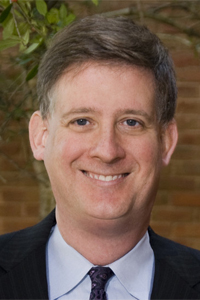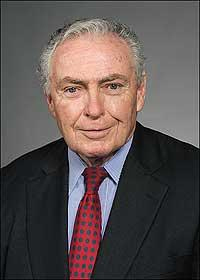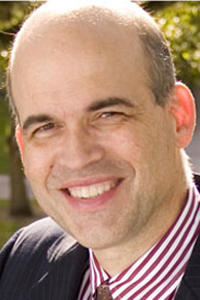BOV, faculty explore ideas for innovations and efficiencies
Support for salary increases and need-based financial aid topped the priority list of William & Mary’s six-year plan endorsed in September by the Board of Visitors.
Now, Board members, administrative staff and faculty are working aggressively to find creative ways to finance the expenditures needed to make the plan a reality.
A key part of that effort to find new resources will be academic creative adaptation, Board members, faculty and staff agreed during December’s Committee on Strategic Initiatives meeting of the BOV. The six-year plan is part of a new ongoing process that began last summer following the Higher Education Opportunity Act (TJ21). Pursuant to the new legislation, all public universities submitted six-year plans to the state earlier this year.
 “We aspire
to be a leading university in implementing the engaged learning model,” said
Board member Robert Scott, who led a discussion on the topic with fellow Board
member Colin Campbell. The Board looked at how William & Mary might
approach a project to increase both efficiencies and innovation on the academic
side of the institution.
“We aspire
to be a leading university in implementing the engaged learning model,” said
Board member Robert Scott, who led a discussion on the topic with fellow Board
member Colin Campbell. The Board looked at how William & Mary might
approach a project to increase both efficiencies and innovation on the academic
side of the institution.
“Our immediate challenge is how do we attract and retain outstanding faculty when our current salaries are so far below market levels,” Scott said. “The Board took the important first step in September by approving the proposed expenditures in the six-year plan. The next step is to explore structural changes to enhance our teaching mission.”
Added Campbell, “I think we have an opportunity to make William & Mary the model when it comes to faculty and Board members working together on some really challenging issues facing all of higher education.”
The academic innovation project follows an ongoing effort launched last year to review and identify innovation and efficiency initiatives on the business side. That administrative initiative determined the College has reduced expenditures by $8.2 million since 2008. It also identified more than 60 projects, which, when fully implemented, could produce more than $2 million in annual cost savings and net new revenues.
 The College
has a well-established record of stretching its limited resources. For example,
U.S. News & World Report’s most
recent list ranked William & Mary tied for 33rd nationally among
all universities in terms of quality but just 97th in finances -- by
far the lowest resources ranking of any university in the magazine’s overall top
50. The gap in rankings between academic quality and financial resources -- at
64 spots -- is also largest of any top 50 schools who are also among the
College’s peer group established by the State Council for Higher Education.
The College
has a well-established record of stretching its limited resources. For example,
U.S. News & World Report’s most
recent list ranked William & Mary tied for 33rd nationally among
all universities in terms of quality but just 97th in finances -- by
far the lowest resources ranking of any university in the magazine’s overall top
50. The gap in rankings between academic quality and financial resources -- at
64 spots -- is also largest of any top 50 schools who are also among the
College’s peer group established by the State Council for Higher Education.
On the academic side, the question is how can William & Mary enhance its educational mission, and do it in a way that allows the College to best utilize the limited resources already in place? It’s a question that everyone agrees is essential to the future success of William & Mary.
“The goal here is to become even more efficient than we already are,” said Alan Meese, Ball Professor of Law and faculty representative on the Board of Visitors.
Faculty support the effort of looking for ideas to free up resources for the long-term, Meese said. This includes the Creative Adaptation Fund recently announced by Provost Michael R. Halleran. The provost sent a memo earlier this semester to faculty announcing the fund, which sets aside $200,000 for the coming fiscal year 2012-13 “to engage and unleash the creative energy in the academic areas to develop creative adaptions that improve the quality of our educational programs either directly or indirectly, by reducing costs or generating new revenues and thereby providing funds that can be reinvested in people and programs,” Halleran said in his faculty message. The new fund is designated for academic units only, though some projects may have an operational or business component.
 Meese added
that the Faculty Assembly Executive Committee also unanimously endorsed the provost’s
new five-percent reallocation plan. In addition to the creative adaptation
fund, Halleran has asked each dean to find over the next three years cumulative
reductions in cost or new revenues (not including undergraduate tuition) equal
to at least five percent of their operating budget. The memo contemplates that
different units might locate such savings in different ways, consistent with
its individual mission.
Meese added
that the Faculty Assembly Executive Committee also unanimously endorsed the provost’s
new five-percent reallocation plan. In addition to the creative adaptation
fund, Halleran has asked each dean to find over the next three years cumulative
reductions in cost or new revenues (not including undergraduate tuition) equal
to at least five percent of their operating budget. The memo contemplates that
different units might locate such savings in different ways, consistent with
its individual mission.
“Faculty recognize this is not a ‘one size fits all’ approach,” Meese said.
The plan, Halleran said, is to reallocate the savings into salary increases. “Compensation is a critical issue and one way we are going to deal with that is reallocation,” he said.
The discussion at the Board meeting follows a number of ongoing discussions on campus. Earlier this semester, Campbell and Scott spent several days on campus to gather information on how best to approach the academic portion of the innovation effort. The Board members spent time with a number of faculty groups and the deans to better understand current issues and constraints.
“The discussions have been truly rewarding. I can’t think of a better experience,” said Campbell, who currently serves as president of the Colonial Williamsburg Foundation and comes with his own academic credentials serving as the former president (1970-88) of Wesleyan University. Scott also comes with an academic background as a former law professor at William & Mary, law professor and former dean at the University of Virginia Law School and currently a law professor at Columbia University School of Law.
 The focus of
the creative adaptation effort is to explore new ways to fund the unusual brand
of education at William & Mary that blends a liberal arts college with a
top research university. During the faculty meetings, Scott said, there was a
general consensus on three possible initiatives that could enrich the
educational value, improve efficiency and encourage innovation:
The focus of
the creative adaptation effort is to explore new ways to fund the unusual brand
of education at William & Mary that blends a liberal arts college with a
top research university. During the faculty meetings, Scott said, there was a
general consensus on three possible initiatives that could enrich the
educational value, improve efficiency and encourage innovation:
- Increase the teaching commitment of those faculty who are able to do so. This could include adjusting teaching loads based on scholarship and research performance. It could also include recognizing what is called “invisible teaching.” This includes the many hours faculty devote to working directly with students outside of the formal course structure. That additional time, usually associated with active research, is not currently calculated in a faculty member’s overall teaching load. Board members and faculty said it’s important to capture a new coursework model that recognizes “invisible teaching” and research and scholarship achievement. It’s also important, they said, to do that in a way that does not impact the academic culture that distinguishes W&M faculty. For example, professors at the College currently give freely of their time and value one-on-one student interaction. We don’t want to make that “gift” of time too structured.
- Rebalance the number of tenure-eligible and non-tenure eligible faculty. The idea here, Scott said, would be to bring in more full-time teachers with no research commitments. “This would require us to integrate our non-tenure eligible faculty more into the life of the campus community,” said Scott, adding the College could enhance the teaching responsibilities of non-tenure eligible faculty and free up resources for other faculty.
- Identify more “creative teaching” initiatives to better utilize the skills and talents of different departments. Scott said one current constraint is department silos. He used the example of a wheel with five spokes – five departments may teach five different classes that satisfy the same curriculum requirement. The College could teach one class (instead of five) and achieve the same academic goal. “If we could get rid of those constraints, or at least loosen them, then many of these opportunities are here for the faculty,” Scott said.
As the effort moves forward, Board members, staff and faculty agreed that the central role of research at William & Mary must not be lost in the academic innovation effort. William & Mary faculty are scholars who love to teach.
“Our blend of teaching and research is highly unusual,” said Halleran, “it’s what makes the W&M’s brand of education so special and valuable.”














